To sit in waiting worship is to have legs bouncing, fingers tensing and relaxing, nails picking off polish of other nails, mind not settling but looping through ideas and half thoughts, body occasionally slightly rocking and twitching, face grimacing, and eyes fluttering to create sensation.
All is just energy tamped down and contained.
For what?
Effort spent to conform.
For what? More frustration and continual reminders that I am different?
Messages swirl in my mind, but no words can come out.
Is that being tamped down, too? A casualty of the attempts at conformity?
I am an autistic Quaker with obsessive compulsive disorder, attention-deficit/hyperactivity disorder, generalized anxiety, and speech and movement disorders. I wrote the passage above as part of a two-page running commentary during a realization of why I had not been attending meeting for worship. During my lamenting, I realized the accommodations I successfully used elsewhere were not available at the meetinghouse. At work and at home, I use accommodations such as clear directions, lists, and agendas for meetings, and I schedule flexibility and opportunities to move and take breaks as needed. In addition, I have multiple avenues of communicating and coworkers who understand that my ability to focus fluctuates greatly. I was unclear if suggesting these sorts of accommodations at Quaker worship would be welcomed or if they went against what the community expected for worship, since no one talked about these things. So after writing about my observations of my spirit and body, I took a big leap and shared this work with others, including a Friend named Angie.
We have been friends for five years. After reading my letter, Angie lamented that she had noticed not only my absence but the absence of others as well. She felt sad and a bit guilty that she hadn’t known the reasons for my not attending worship, but was extremely grateful that I could trust her with these ideas. I hadn’t shared these needs and the depth of emotion before, and my vulnerability struck a chord. The most common question I received was this: “If a meeting becomes inaccessible to its current or changing membership, how does the community take action to address the true needs of all who are present?”
This query, like many queries in the Quaker world, spurred great conversations that aligned with larger conversations already taking place. Recently, North Columbus Friends Meeting in Columbus, Ohio (NCFM), came into unity on the topic of the inaccessibility of the meetinghouse and agreed that major repairs would not fully address physical accessibility needs for bathrooms, doorways, and entrances. The meeting began an ongoing search to secure a location that would fit the needs of our diverse community.
While NCFM acknowledged the physical accessibility issues as well as it could before relocation, there seemed to be an opening to expand how we traditionally talk about accessibility to include that of neurodivergence among Friends. After sharing the letter with the Ministry and Nurture Committee, everyone agreed it was important to meet to talk about this. Angie attended as a support person for me. We were both excited for the opportunity but unsure and nervous about how it would be received with people who are not as close to me socially.
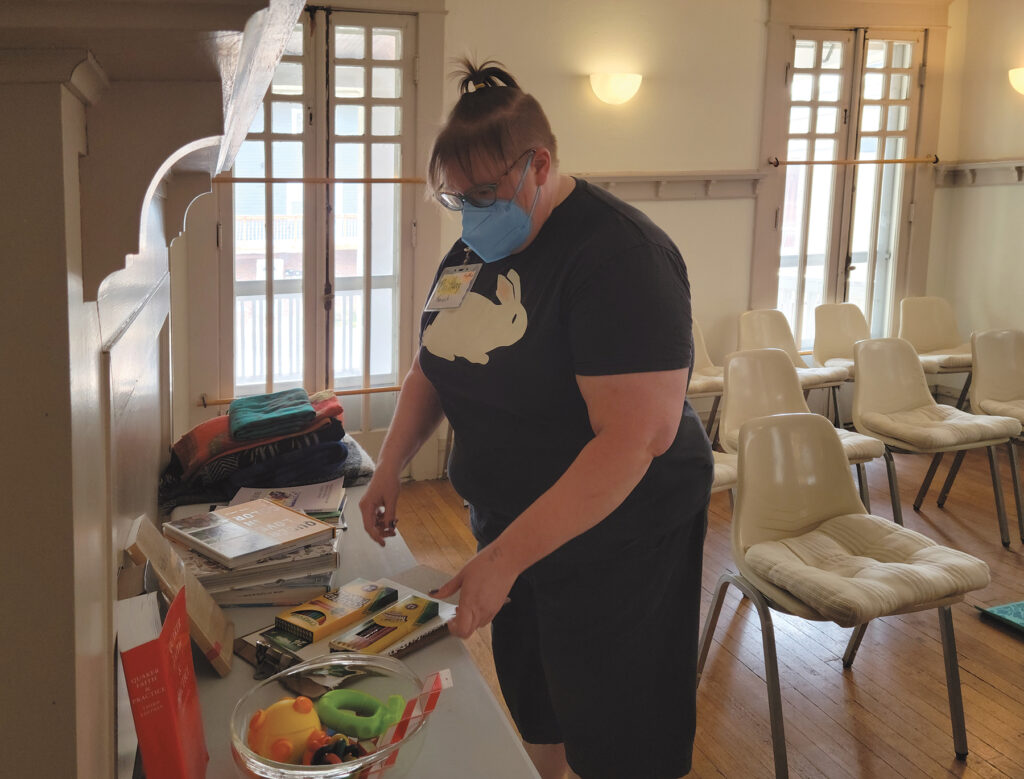
Gathering
In the gathered space with the Ministry and Nurture Committee, Spirit seemed to move differently from how it did when I shared the letter and my needs with others in my immediate circle. It was emotionally and physically exhausting to have to re-explain and describe the ways that worship has been inaccessible. Thankfully, Angie assisted by reinforcing and summarizing points that I had already expressed, or she phrased them in different ways. Having an explicit support person there, was a great asset in relieving the stress of being the sole experiencer. I wasn’t alone and my needs were important.
During the process, everyone agreed to some updates to the meeting for worship facilitator’s welcoming speech (this is a short introduction to worship in our meeting in which we briefly explain why we’re gathered and what to expect). These changes acknowledged that those in attendance are all human and have different needs, that people are welcome to move and fidget, to share messages in a variety of ways, and to engage in quiet activities that help some settle and center. However, many in the Adult Young Friends (AYF) group, myself included, were concerned about the perfunctory nature of these changes and how they lacked a sense of joy and welcoming. So together, we crafted some queries. AYF wanted to draw attention to how these accommodations could bring new Friends to meeting, encourage old Friends to return, and reduce stress of those powering through their own discomfort. AYF did want to acknowledge that engaging in quiet activities or using fidgets might disrupt others’ settling. However, it was essential to try and explore the root cause of these requests: that humans have different needs and there are many ways we can worship together.
Queries
In The Disabled God, Nancy Eiesland draws on the themes and advances of the disability rights movement to identify people with disabilities as members of a socially disadvantaged minority group rather than as individuals who need to adjust.
- How might a bonus meeting for worship contribute to the liberation of disabled people in our community?
- How can the joy of an additional meeting for worship help shape our lives in the Light?
- What can we learn from this additional meeting for worship? What practices might be carried over to the morning meeting for worship?
The new welcome speech was a start but was not holistic enough to truly create a space where I felt fully supported, so I still did not attend, much to my dismay. Meanwhile, Angie had crafted a proposal for an afternoon meeting for worship, designed with disabled attenders and differing needs at the forefront, not as an afterthought. This stood in contrast to how many meetings and systems were set up and still operate.
The proposed meeting would start at 2:00 p.m. to accommodate parents with young children, folks who had to work a morning shift, or college students who are more available in the afternoon. This meeting for worship would last 30 minutes instead of 60 and skip any announcements or long introductions. Finally, it would specifically celebrate the many ways Friends need to settle on their own terms, such as by fidgeting, coloring, changing locations, taking breaks, and utilizing a variety of seating. Feeling hopeful and satisfied with how the afternoon meeting addressed the needs of many Friends, Angie took this proposal to Ministry and Nurture.
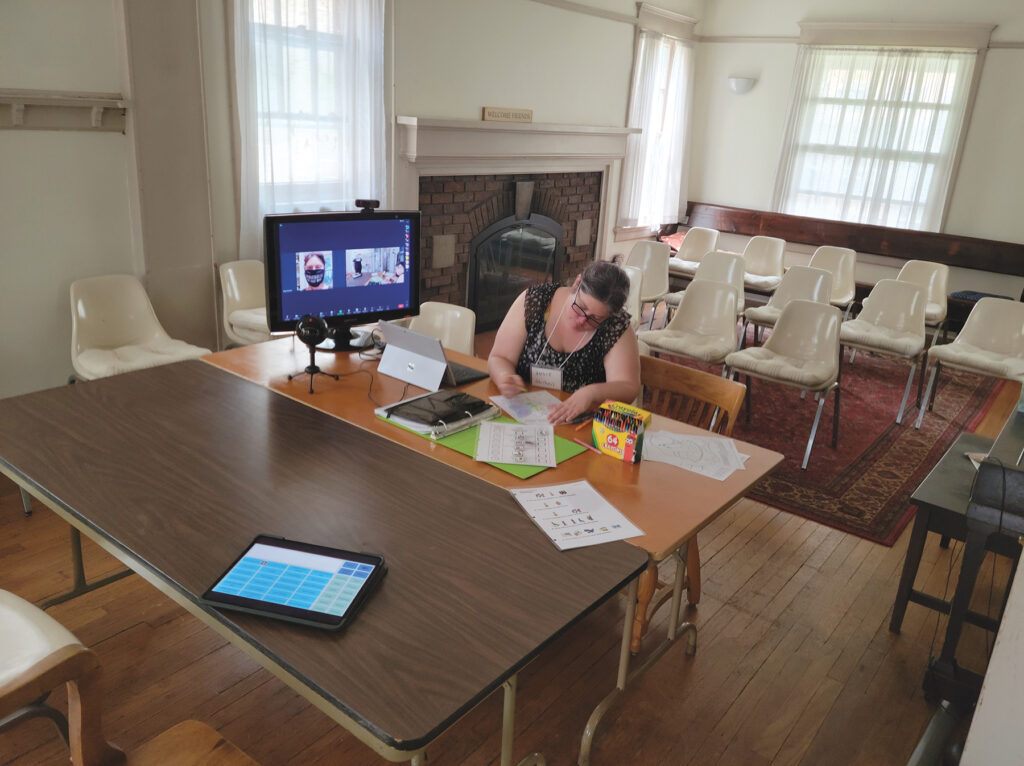
Deep Listening
With the full support of the Events Committee and AYF group, Angie met with Ministry and Nurture. Initially, the committee shared concerns that adding another version of meeting for worship might create separate groups within the meeting. Some thought that the adjustment to the worship facilitator’s script was enough and showed that NCFM was sensitive to the needs of disabled people. One member expressed a desire for Friends who needed accommodations to “meet halfway” since NCFM had already done so much work regarding accessibility. It took a lot of discussion and discernment, but eventually Friends were able to see that accommodation is an ongoing process, that just as we would make adjustments for Friends’ physical needs, we should make adjustments for their neurological, sensory, communication, and cognitive needs.
I still had lingering concerns, but I was not yet able to articulate that something about all of this didn’t yet speak to my heart. After being open to Spirit and listening during the final meeting with the committee and before the presentation at meeting for worship with attention to business, I realized what was off and what had been the difference all along: it was lacking joy and a spirit of true welcome. When I initially shared my letter with my close friends, it created much hype, dreaming, and wonderment. Most in my circle were disabled themselves or shared experiences with someone who is disabled. We were all working on recognizing internalized ableism and thus no longer had strong biases against the disabled state of being. We dreamed about what a fully accessible meeting for worship could look and feel like. The joy of being free with Spirit could be astonishing only if accommodations were in place and others were invited to join us as whole humans.
During that final meeting, Spirit compelled me to share this hope: a hope that others could also see the joy and unbounded depths of love that this afternoon meeting for worship could cultivate. The clerk of the committee then rephrased his proposal speech, outlining how the community can recognize the wide and varied needs of people and that this was a time to raise up those among us who have expressed needs and to marvel at the ways we can gather. Finally, I felt assurance and optimism.
Sense of the Meeting
Overwhelmingly positive! That was the reaction during the meeting for worship with attention to business. After hearing the proposal, many Friends expressed appreciation for spearheading a different version of meeting for worship that met the needs of all Friends. Those in attendance remarked that it could be an opportunity to bring in more Friends and attenders, to bring back Friends who had not felt accommodated at morning meeting, and to open the door for new ways to gather in worship.
To start promoting the event, I shared it online, steeling myself for the unknowns that online comments can bring. More surprises! I posted it to Reddit’s “r/Quakers” community and positive comments rolled in. In six weeks the post received over 2,300 views and a 95 percent positive rating. One user commented: “As a disabled person . . . I think the idea for the shorter afternoon fidgety meeting sounds so fun and powerful! I would love to get to experience a Quaker space with such beautiful and plentiful neurodivergencies!” Another said, “This is amazing. Most faith leaders just go ‘deer in headlights’ if you even mention these kinds of needs.” Now we just needed to host the first afternoon meeting for worship.
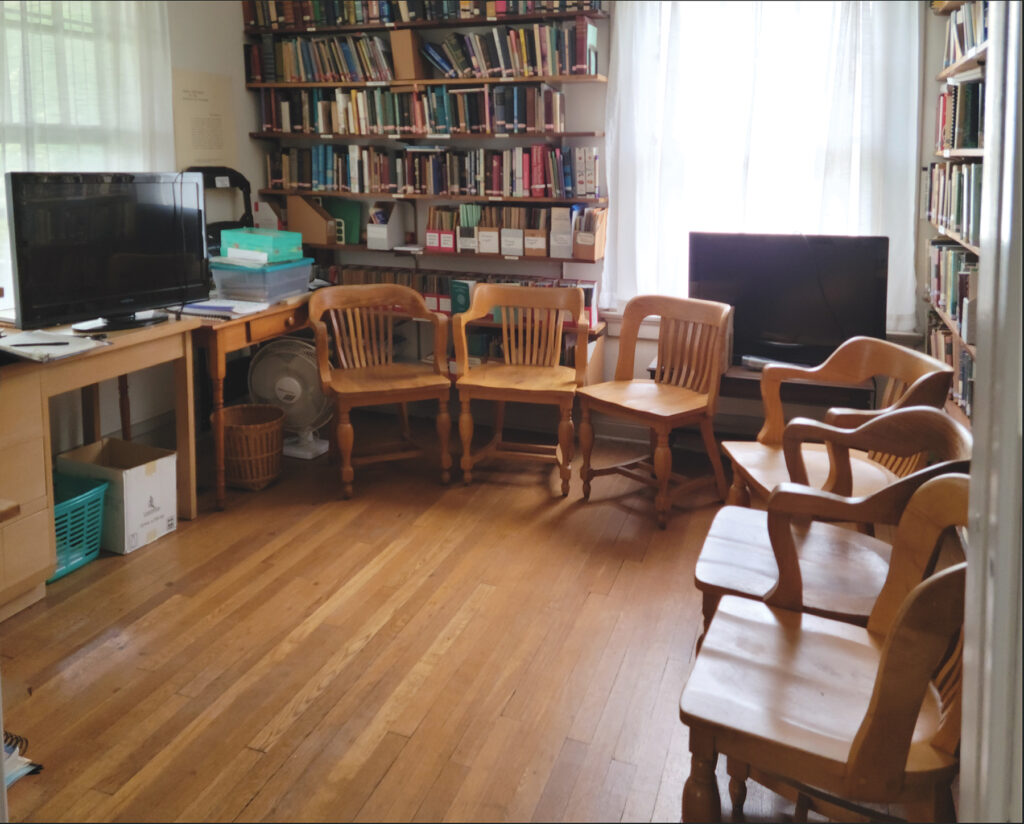
Ongoing Adaptations
Angie and I were motivated by the positive responses, both online and from Friends in NCFM, and started to prepare for the first afternoon meeting for worship. Using my knowledge as a special education teacher, I created a picture schedule and a picture version of the expectations outlined in the facilitator’s welcoming speech. Angie, along with AYF, gathered fidgeting and other supplies, and we talked about ways to rearrange the room to facilitate and encourage movement.
Finally in May of last year, eight months after coming forward with my letter, I attended meeting for worship again. Being able to pick my seat, fidget, wiggle, experience tics, and draw in a space where I wasn’t alone—I wasn’t different—was freeing. I brought along my iPad that has a speech app on it. Sometimes words get stuck in a traffic jam in my mind and can’t come out, so writing them out is easier. Having all this in place helped me settle more easily. Although I have not used it yet to share a message, I do treasure the knowledge that the message read out loud via an iPad will be listened to on par with a message shared verbally.
The session was well-attended both online and in person. Angie acted as worship facilitator and encouraged folks to worship in any way they felt led. Some Friends in attendance sat as they would at morning worship; some read; some colored; some sat on the floor and played with slime. It was what everyone needed that day, according to their own needs, with no judgment.
Afterward, attenders shared their feelings about finally being able to be a human at meeting for worship. Reactions ranged from being delighted to use the accommodations to being grateful to have the option to use them, and some Friends noted that just being in company of others who appreciated accommodations alleviated stress and allowed them to settle. One Friend shared:
This meeting was the first time I’d ever worshiped in the manner that feels most authentic to me outside of the privacy of my apartment. Looking around the room, I was struck by the idiosyncratic ways in which each Friend’s inner teacher guided them, and the gift allowing our inner teachers to teach and learn from one another in turn.
North Columbus Friends Meeting will continue to adjust and be open to changes. Those involved in supporting Angie and me learned that Quaker process can be a great source of compassion to allow room for Spirit without letting biases and fear of change get in the way. All involved hope that others connect with what was shared so openly here: to contact the authors and share resources so that the community can thrive and grow and so that others can experience compassion and support from a loving Society of Friends. That’s a disabled person’s life: ever changing due to ever-changing needs; relying on others; having others rely on them; and, in essence, being human. I encourage all of us as Quakers to look inward and see the ways we limit ourselves and others. How do we actively increase accessibility in all of the spaces we inhabit in some way? How do we open up those spaces? How do we engage without judgment, unless we actively inquire into what, who, and how we judge? Respecting and responding to disability needs is respecting and responding to humanity. Strengthening community and being there for someone during their highs and lows, trusting others, and being aware of biases are ways that this community will persist.
Afternoon meeting for worship visual schedule (left) and first page of expectations with pictures (right); both were created using Boardmaker, a software program for augmentative and alternative communication.
Ways to Increase Accessibility
- Update your meeting’s online presence. Disabled people need to know an event’s details in advance in order to plan and see the space through pictures and video via an accessible website and social media.
- Use unambiguous speech about what accommodations you have in place and why. Be proud that your meeting has accommodations for disabled people and that you are prepared to work with people if needs are not yet met.
- However, if an accommodation is not possible such as making stairs accessible for a wheelchair user, acknowledge your meetinghouse’s shortcomings and apologize. Consider offering hybrid meetings until the meetinghouse can be made fully accessible.
- Work with disabled people in your meeting and local disability advocates/consultants. Your meeting’s needs are unique; address them.
- Be open to change and improvements. Find ways to host educational events to help build understanding in the community. This education drives openness, confronts biases, and helps continue conversations.
- When implementing solutions, use clear language to say that this is an ongoing process, and it may be messy and different from what was before. Appreciate the wonder and joy this can bring.


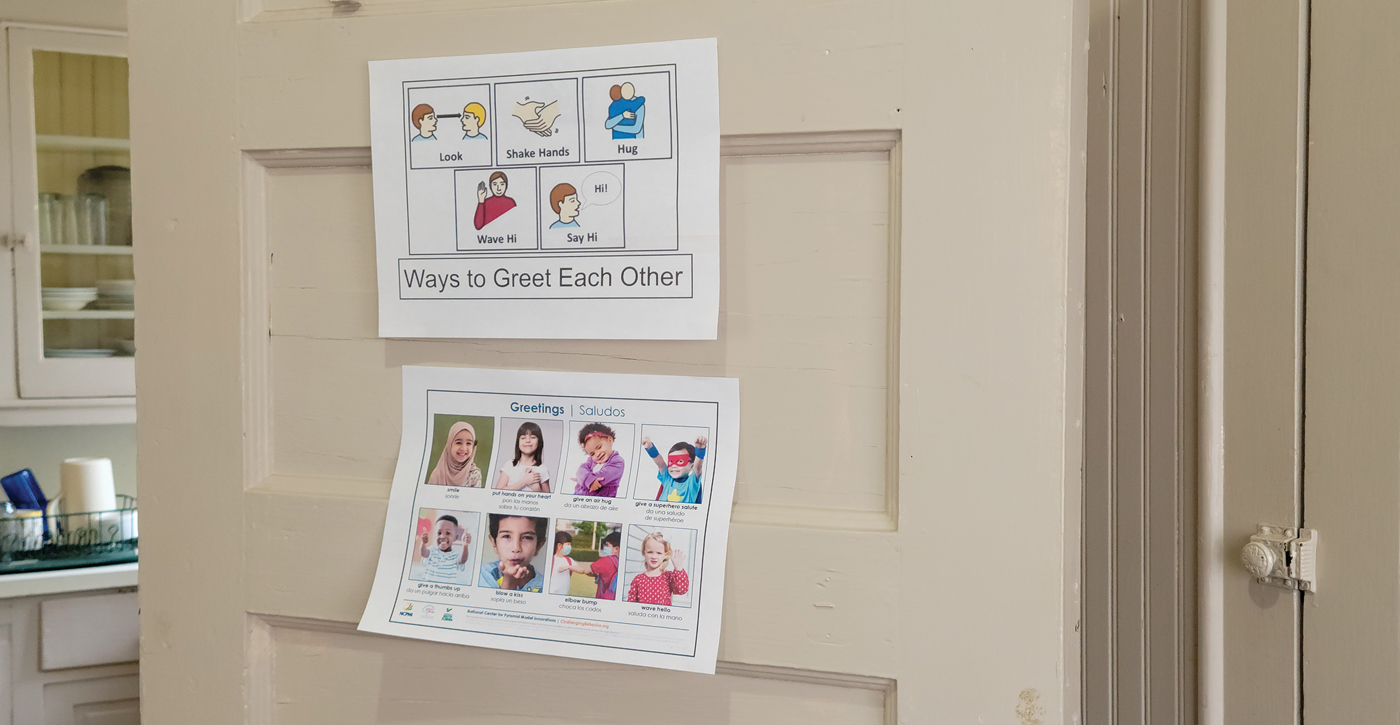


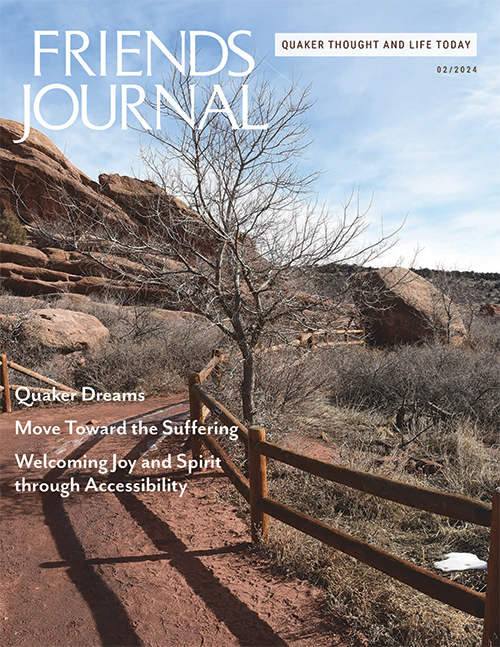
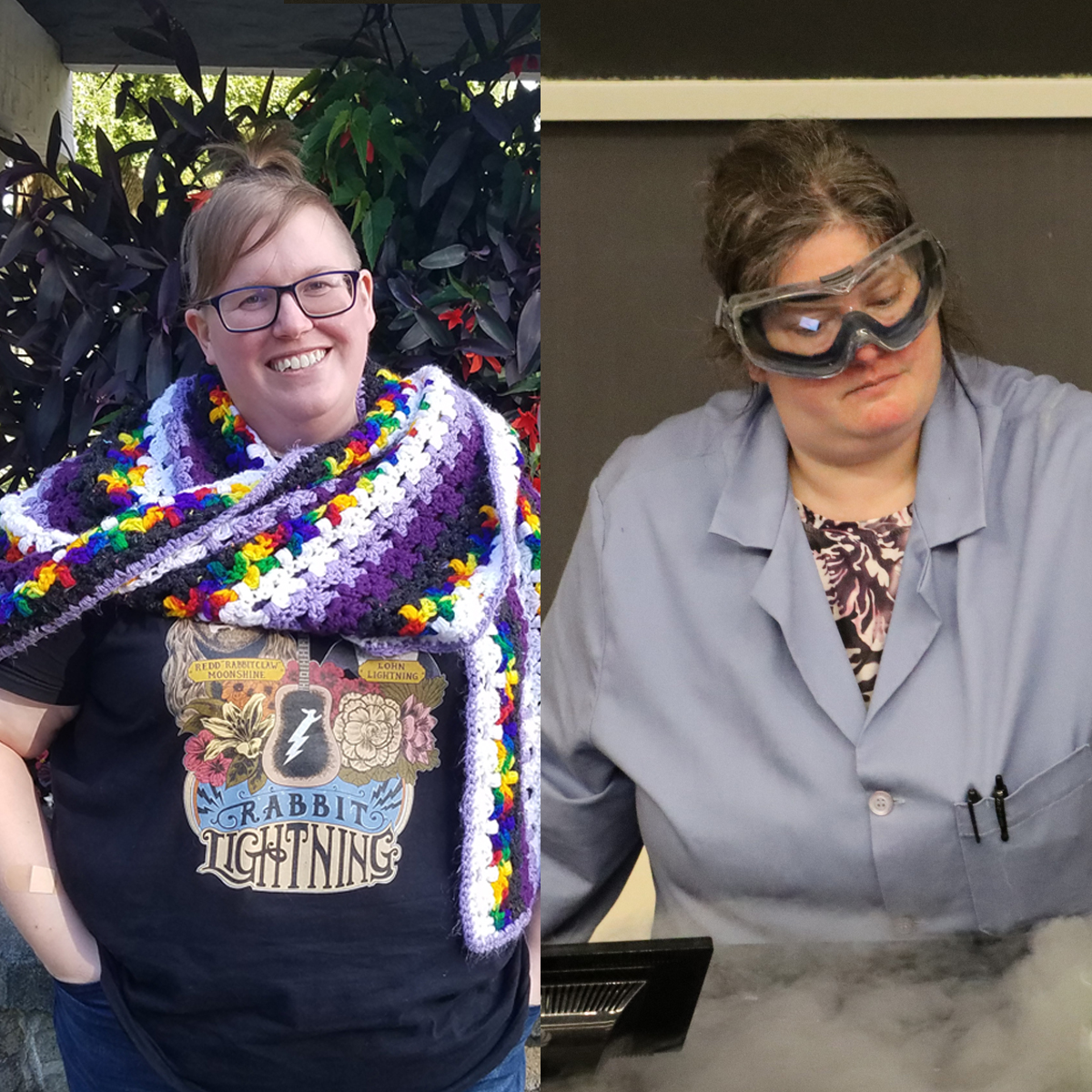
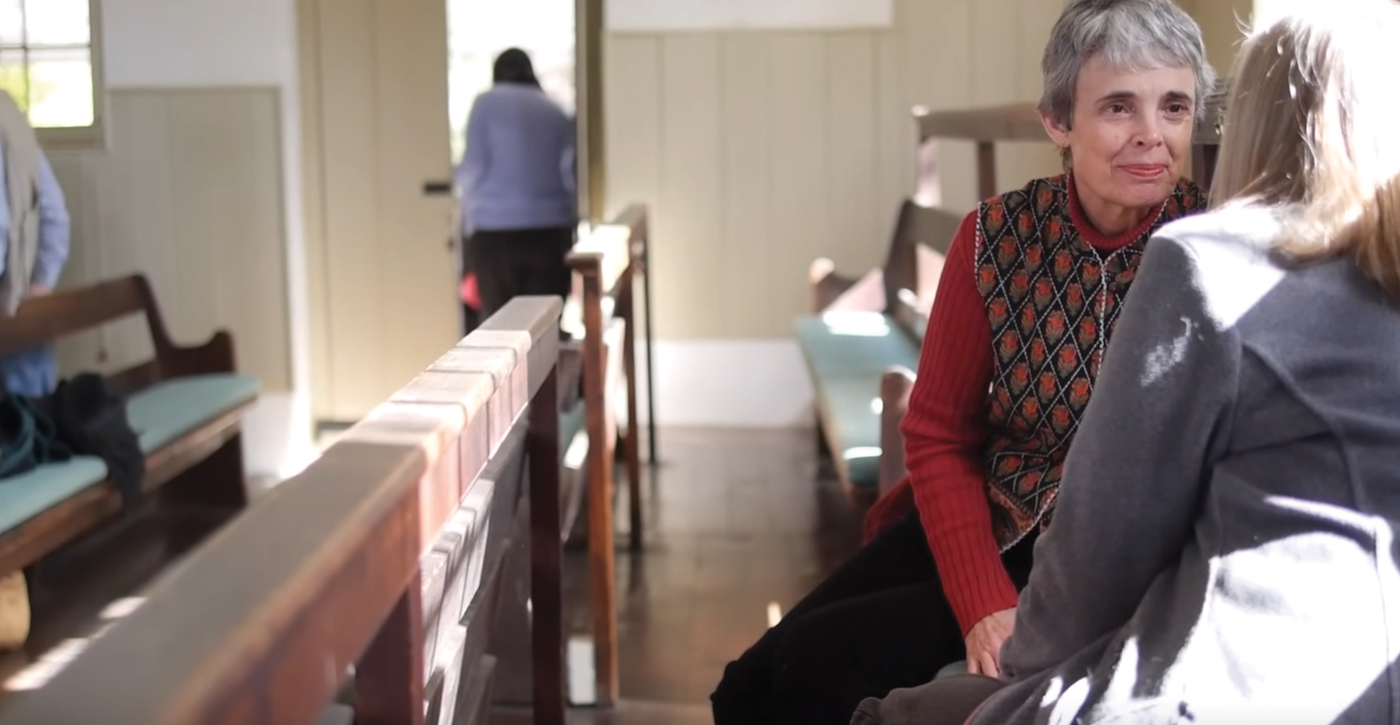
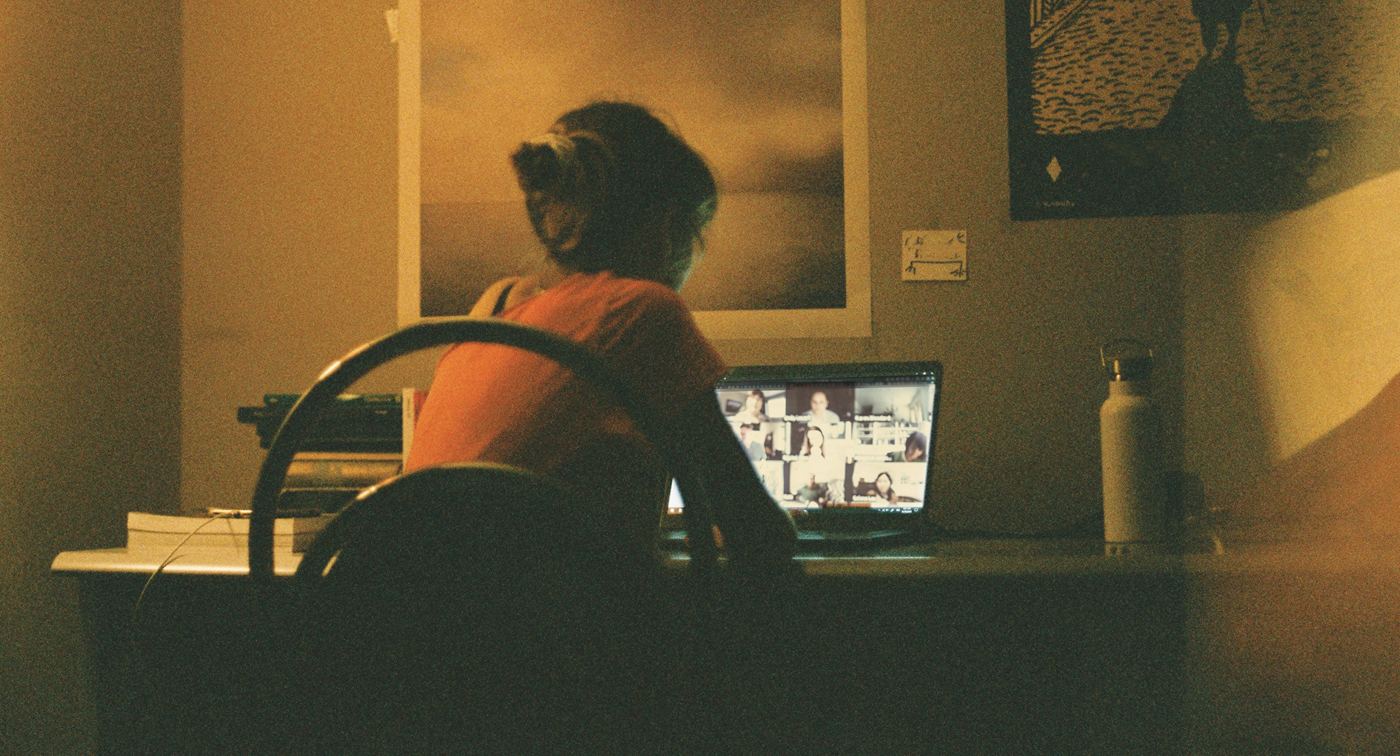
Very impressive solution! Due to evolution, most boys can not sit still very long, getting in trouble at school, so giving flexibility for quiet activity helps tremendously. To settle, would quietly standing, pacing, or using a treadmill in the back of the room be tolerable?
Yes, we welcome movement at the Afternoon Meeting for Worship. To help facilitate this we have exercise mats and balls to sit and lay on. Folks are welcomed to move as needed.
Accessibility is never really complete, we’re always learning new ways to help each other but at the core, it’s still a time to be together in waiting worship.
I love movement too! Walking meditation has always been one of my favorites.
Exactly! This was my reaction. As a young boy this would have improved my experience tremendously. I wonder how many of my peers would have stuck around if this had been available 20-30 years ago.
Thank you for sharing this story, Brittany! I know that, because of the publishing process, it’s been a while since this article was written. I wonder how your personal experience of waiting worship and your meeting’s support has continued to evolve since then? Are there any new insights you can share now that more time has passed and Afternoon Meeting for Worship has become a more usual part of your and your meeting’s routine?
The disabled community knocked and North Columbus Friends answered. For a wider spiritual community whose numbers dwindle we should be focused on how to increase attendance. Almost at any cost. In my opinion Accessibility is included in Stewardship. Come on y’all, let’s leave it better than we found it.
This article, the changes NCFM made to their meeting, embodies the welcoming nature that I have come to associate with Quakers. Instead of asking why we should change, you asked what they could change to be more welcoming and accessible to their community. Thank you for sharing these ideas for other communities to use.
I’m curious, now that you are presumably several months into having the second meeting, have you found any other changes to make based on feedback from attendees?
Angela, thank you for your thoughts.
So far others haven’t asked for or offered any other accommodations. I did just posted on Reddit r/Quakers asking what other accommodations people use. I’m hoping to learn from others so that we can have lots of options, not just the ones that the current attenders already use. Trying to be proactive instead of reactive!
In the same vein, I’m hoping that we will soon have a signed agreement with an American Sign Language interpreter service so that 1. we can promote and offer one and 2. if/when someone does request interpreter services, we can schedule one quickly.
Hear, hear! Accessibility fits into so many Quaker values.
Clear Creek Friends Meeting in Richmond, Indiana (where Earlham is) hosts an unprogrammed meeting for worship at 10:00 am and an semi programmed “college” meeting for worship at 1:00 pm which has featured music guests. My Quaker circle I attend here in Marshall, NC (under the care of Celo) starts in the afternoon as well and goes for 45 minutes. It exists because we Friends in Marshall don’t want to drive over an hour to get to meeting at 10:00 am. Accessibility has been happening and needs to continue to happen.
My favorite part of this story is your centering of joy! That the changes didn’t feel right until they were undertaken in a spirit of curiosity and gladness.
In Protestant traditions, it can so often feel like austerity is somehow a necessary part of worship and spiritual deepening, as though overcoming discomfort were a rite of passage. But what you model here rings true for me — it doesn’t have to be so hard. A deeply felt sense of joy and ease are important indicators of Spirit-led decisions.
Brittany,
I am enthralled by this, for the idea of what appropriate behavior is for a Friend during worship has now haunted me for the ten years or so that I have been going to meetings. My whole life I have found grounding in writing and drawing, and I have struggled with meditation and waiting in silence. At some times in my life I have been able to be successfully grounded for the hour long meeting time, but at other times I have struggled so badly to sit there and not move that I have avoided to go to meeting too. I have found that bringing some artistic activity to stay focused on has calmed my mind and I have over the years brought a sketchbook with markers, a journal to write in, something to knit or embroider and even a book to peruse and meditate on. These practices have helped me immensely but I have never been sure if they were accepted in that space and I have often felt uncomfortable engaging in them and never brought them up explicitly. Therefore I have been a bit wishy washy with the consistency of introducing them into the space. I definitely think my attendance would have been better and I would have felt more welcomed if I knew that these practices were defined as not only allowed but cherished.
But now, you have pointed out that such activities are actually essential to us being a welcoming community where everyone can join in worship and have their voices heard. As a former attendee, I am so proud of what you and the meeting have accomplished. I hope other meetings can follow suit. How can we spread this idea to other Friends communities? Do we still need more time to determine best practices and implementation strategies? I can’t wait to visit Columbus, Ohio again soon and see it in action.
Silence, stillness, waiting, listening are so much more than posture and indeed, may become a “pose” we assume to fit surrounding culture. Brittany and Friends slip past any stereotyping in an experiment with authentic being – showing us all the way to a more simple, integral practice. I wonder if you might share more on how this way of gathering raises the spirit of goodwill among participants? Thank you!
What an incredibly well thought out and written article! It really brings to light the idea of visible disabilities/needs vs. invisible ones. Quakers have helped with radical shifts over time periods when it comes to inclusion. However, these shifts have been based on visible differences. We have sat around and let the elders define how Meeting and worship should look. It has been difficult to challenge that, and too often, those with differences just leave. Thank you for bringing this to light! I believe other Quaker organizations should reprint this.
And the people who leave are the younger generations not feeling heard or included, which is true in the vast majority of meetings and churches in the US.
We blame the internet or covid or young people, but who wants to participate with an inflexible group that does not carefully listen to other views?
Lily (above) has commented on incorporating a sense of joy. What strikes me is a sense of abundance, from the idea of a “bonus” MfW. To have “bonus” ways to worship is delightful and inviting. Neurodivergent or folks with different needs/modalities for being/expressing, are not “less than,” as is the stereotypical way of thinking about disability — they are part of the Garden of Eden with all God’s creatures, some singing low and others higher. Some questions: if it’s true that people are not opposed to change but that they resist being changed, what are good ways to involve the whole worshiping community when modifying ways to worship? How do you literally welcome people when they physically show up or check out your website in advance? As a Quaker for 30 years, I’ve often thought that Friends are simple but not always clear in communication, so I really appreciate the emphasis on clarity, whether verbal, visual, or whatever. Thanks, Friends Brittany and Angie!
This is wonderful. There are so many clear and practical ideas for making meetings more accessible listed throughout the article, I think a lot of meetings can take inspiration. And the focus on joy and enthusiasm really accentuates that improved accessibility is an excellent opportunity to open our meetings to more Friends. I think that’s something to be excited about. Kudos to the author and thank you for sharing your ideas and your experience.
I really appreciated this article on a number of levels and I have a few questions. The writers mention that a community member suggests “meeting halfway “- within relationships this is often problematic- what would supporting folks with disabilities “all the way” look like?
Also- please tell us more about the importance of “unambiguous language describing accommodations.”
Lastly I really resonated with this beautiful concept- “celebrate the many ways Friends need to settle on their own terms.”
Hello Jennifer, Angie and I loved talking about this in the video.
We related it to how everyone uses the internet to look things up now. Going to a restaurant, you look up the menu. Going to a concert? You look up the parking/bus situation.
It’s all information that we have at our fingertips and accommodations should be no different.
Using clear, plain language helps guarantee that the accommodations that are present are truthfully there.
Take our old Meetinghouse for example, we could have said on the website that we have an accessible entrance and left it at that. However that is not the whole truth. Yes there is concrete ramp from the (gravel) parking lot to the door but then there are steps into the door and then more steps when you get inside the door! How awful would if feel if you came to join in a Meeting for Worship but only able to use the ramp up to the door and that’s it?
https://youtu.be/QnBeT6xvoYU?si=Fz3tmSr_Dagxid31
For centuries, building a separate meeting space made sense due to lack of community spaces and religious discrimination. Today, most communities have public spaces for meetings that are accessible and would serve our needs without costly (time, talent, treasure, testimony) on building upkeep and maintenance, which would be better spent on loving God and neighbor. Perhaps we should consider converting or selling the buildings to daycare or affordable housing or another need, perhaps better funding old or new activities and improvements in our communities.
Dear friends, dear friends, Let me tell you how I feel. You have given me such treasure, I love you so.
Brittany and Angie,
Thank you for shining a light in the darkness for others to see. You are leading a path and using compassion, conviction, and intelligence to create and implement solutions, to create a more welcoming and inclusive spiritual community. As a Buddhist and a community college instructor, I share your values of inclusion, kindness, and create problem solving, and laud your efforts with North Columbus Meeting. My question is, how do you continue to implement these strategies in the face of opposition or, more likely, resistance? Change is never easy. Do you think an attitude of resistance to change could hinder these or similar strategies from being implemented in other Quaker communities? How could you suggest ways to encourage less forward-thinking communities to adopt similar policies?
With love and admiration,
Susan
Hello Susan, thank you for your time and heartfelt reflections.
If there is resistance, hopefully all involved can reflect on Quaker principles, many apply to accessibility, chiefly community and equity. Also using Quaker practices like taking time to think and thresh things out are always a big help. Of course these work best in Quaker communities.
In other communities that are not always centered around shared values, good old fashioned forms of protest can be helpful like petitions and sit-ins. Newer methods like showcasing the injustices on social media could be helpful too. All of these methods take time, attention, and people power, which can be hard for disabled activists since their time can be eaten up by inaccessibility or their health concerns.
Finally, the easiest answer is to make things with disabled people in mind in the first place.
I thought this article brought to light a situation that has needed to be addressed for awhile. After read the article, several questions came to mind such as what motivated the article be written? What is the background and did it help to view the situation and then make suggestions for adaptations? Is a person or group ever involved in making adaptations that they feel are needed or do they have to go through a committee? I have found that knitting has helped me in various situations. I bring my knitting to church and have now had other knitter’s sit in the same area I am.. no one in the church seems to question the reason I am knitting.
Thank you, Brittany and Angie, for sharing your experience and practical suggestions for joyfully welcoming the many ways spirit moves within a human body! There can be many unspoken assumptions about what is “right behavior” in meeting for worship…and sometimes the unspoken assumption is that Friends will be unwelcoming. As a person with chronic pain who often finds it uncomfortable to sit for an hour, I have felt a subtle pressure to remain seated else Friends might expect me to share a message upon standing. Would my standing keep another Friend from rising to share a message? I feel greater ease and sense of belonging from explicit community support and openness to diverse ways of showing up (or standing up).
CV Hester Freeman’s thoughts on the miracle of prayer wove closely to my life experiences since accepting Jesus as my savior. Prayer takes many forms, offers relief and support. There is always an ear to listen. Thank you Chester for sharing your thoughts.
Thanks to Chester Freeman for sharing his thoughts and experiences on the practice of “holding in the Light.” What seems especially important is calling attention to the two dimensions of this practice: visualizing another “surrounded by Divine Light” and then following up with a concrete action if needed.
A sentence that caught my attention referred to seeing another “surrounded by Divine Light” is “not a result of our prayers … but of divine grace.” Friend Chester’s one sentence leaves me reflecting on the differences between our “holding someone in the Light” or “able to see another in the Light.”
Thanks, Brittany. This is a current problem at Evanston Friends Meeting, but the issue, although raised, has not been addressed. Yet.